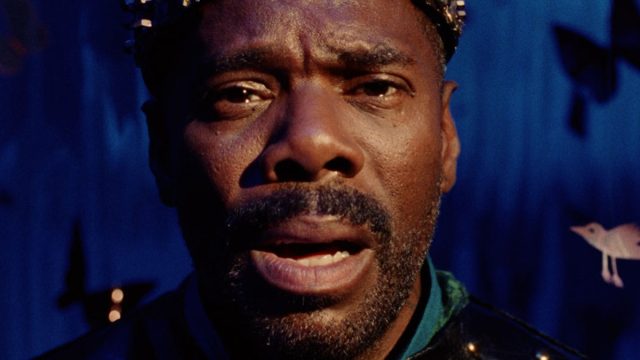Keep this Oscar Nominee in Good Spirits by Discussing:
- his latest movie
- motorcycle photography
- a late TV icon
- a 1999 classic
- doodles!
Send articles throughout the week to ploughmanplods [at] gmail, post articles from the past week below for discussion, and Have a Happy Friday!
Director Greg Kewdar talks to Erik Luers at Filmmaker Magazine about the eight-year journey to make the new release Sing Sing:
I think that when a movie’s time is right and you acknowledge and embrace it, the universe starts to conspire to help you make it. I wrote [star] Colman [Domingo]’s name down in the notebook and made that intention known. My manager, Adam, happened to know Colman’s agent, so the two got in touch, shared the Esquire article between them (since we were starting [the script] over again, we didn’t actually have a script to share at the time), then we all got on Zoom together. Colman was like, “I read the article and have so many questions” and I was like, “Well, I want to tell you about the six years that happened from when we first discovered this article,” and then told him the story of this new version of the narrative we had thought up. Colman responded, “At this point in my career, I’m realizing that there are some projects that are trying to teach you something. You don’t know what it is but you just know that it’s trying to, and, at this point in my life, I’m saying ‘yes’ to those projects…and I’ve got three weeks open in July.” I responded, “We’ll take them.”
Film Comment‘s David Beal goes at length on the photography and filmmaking of Danny Lyon, who inspired the recent movie The Bikeriders:
Lyon’s original book has been fixed in memory for generations of photographers, so it’s easy to forget how fresh it must have felt when it first came out and how much it attempted to push the medium forward. The book is sometimes called an example of New Journalism, but it’s better understood as a self-portrait, a vision of a young man searching for a sense of himself in the people he photographs—scramble racers, army vets, truckers, Brando-worshippers, bug-eaters, and their wives and girlfriends on the blue-collar outskirts of Chicago. Prodded on by the influential photography curator Hugh Edwards, Lyon spent a couple years as a patched member of the Outlaws; he took pictures of the people he loved and the experiences he shared with them. But with their finesse and their lyrical depictions of machismo, the pictures also have a sort of subconscious; they are the kinds of images that might come to an older man in his dreams as he relives the sense memories of his youth: someone’s hair pulled taut by the wind as he speeds over a bridge, the glow of a jukebox in a woman’s eyes, a racer’s pale face splattered with gobs of black mud.
At Slate, Willa Paskin examines the most famous role of the departed Shannen Doherty:
All of this makes Doherty another one of the women we—the tabloids, the viewers, the culture—ganged up on, for crimes not so severe, while men with more power were being far more odious. It was unfair. It was insane. It was typical. But to leave it at that doesn’t engage with what was genuinely prickly in Doherty’s performance. She really had something, but it was close to a soap opera villain thing. Villains are the most beloved characters in that medium because they’re so much more interesting than everyone else: so insatiable, so desirous, so passionate, so self-justifying. Everyone else looks dull by comparison. But 90210 was a teen show—the teen show—and between it and the time, its producers didn’t want to turn its would-be role model into a vamp, to do high-school Dynasty. So they ripped the show up, pushed Doherty out, and installed a proper nice girl in the lead. (Actually, the one who wore the same dress, then stole the dreamy boyfriend, then the show! But she was relatable as hell while she did it!)
For Paste, Hafsah Abbasi writes on the merging of public and private desire in Eyes Wide Shut:
A misreading of Eyes Wide Shut foregoes Kubrick’s sharp focus on Bill and Alice in favor of characterizing it as commentary gesturing toward the grime and muck and banality of perversity in New York City. In this sense, the latter half of Eyes Wide Shut has sometimes been likened to Martin Scorsese’s After Hours, but this isn’t a take I’m partial to. Kubrick doesn’t etch a New York that is informed by an absurdist lens of liberal scare tactics (read: crime in cities). It instead renders each of the city’s characters, working class or elite, a depravity; this wickedness doesn’t indicate the grime of the city but universal sensibilities that are forced dormant under the sheen of the nuclear family.
Polly Dickson writes in The Paris Review about the taxonomy and function of doodling, including the coining of the term in Mr. Deeds Goes to Town:
Our modern understanding of a doodle thus has its premise in a fictional work. What Deeds shows us is the first doodle to be called a doodle, but of course it’s not one; it’s a drawing of a doodle. It’s as if here the scriptwriter has aimed to include all those archetypal forms that we are likely to find ourselves drawing when bored—stars, numbers, swirls, figure eights—drawing them together into the shape of a manic-looking face, such that it can be easily “read.” This gives it a satisfying finish, the snap of recognition. The fantasy of a doodle here, as a signifying system, bears witness to the investments we make in them—those investments have to do with clear, correspondent meaning. If it is mad it is also productive in a quiet and legible manner.

